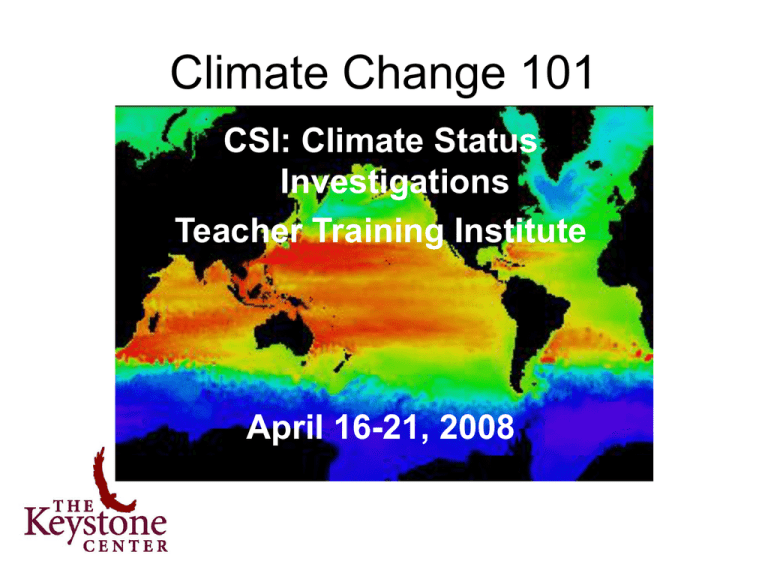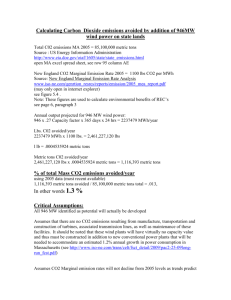Climate Change 101 PPT
advertisement

Climate Change 101 CSI: Climate Status Investigations Teacher Training Institute April 16-21, 2008 Everything I know about climate change I learned at the movies… 1995 2004 Everything I know about climate change I learned at the movies… 1995 2004 2006 Presentation Outline • • • • • The Greenhouse Effect Where Does Our Energy Come From? Emissions Correlation w/Monitored Climate Changes Future Trends Source: EPA Global Warming site. http://yosemite.epa.gov/oar/globalwarming.nsf/content/climate.html Effects of Different Greenhouse Gases CO2 CH4 N2O CF4 SF6 Global Warming Potential (GWP) 1 21 310 6,500 23,900 Atmospheric Lifetime (years) 50-200 12 114 >50,000 3,200 Pre-industrial Concentration (ppm) 280 0.722 0.270 40 0 Atmospheric Concentration (ppm) 381 1.774 0.319 80 5.4 Rate of Concentration Change (ppm/yr) 1,610 0.005 0.0007 1.0 (ppt/yr) 0.23 (ppt/yr) Source: US EPA: US Greenhouse Gas Inventory Reports 2008 http://epa.gov/climatechange/emissions/usinventoryreport.html CONVERSION CHARTS 1 unit carbon (C) = 3.6667 or 44/12 units carbon dioxide (CO2) 1 unit CO2 = 0.2727 or 12/44 units C Converting methane (CH4) and nitrous oxide (N2O) to equivalent CO2 and C units: • Global Warming Potential (GWP) of CO2 = 1 • GWP of CH4 = 21 (over 100-year time period -- IPCC Third Assessment Report) • GWP of N2O = 310 (over 100-year time period -- IPCC Third Assessment Report) EXAMPLE: (100 metric tons of N2O)x(310) = 31,000 metric tons of CO2 Equivalents x 12/44 = 8,454 metric tons of Carbon Equivalents x 2204/2000 = 9,316 short tons C Converting mass units (e.g., short tons, metric tons, teragrams) 1 metric ton (tonne) = 1,000 kilograms (kg) = 2,204 lbs 1 short ton = 0.9072 metric tons = 2,000 lbs 1 Teragram (Tg) = 1012 grams = 1 million (106) metric tons 1 Gigaton (Gt) = 1 Petagram (Pg) = 1015 grams = 1 billion (109) metric tons Presentation Outline • • • • • The Greenhouse Effect Where Does Our Energy Come From? Emissions Correlation w/Monitored Climate Changes Future Trends Fossil Fuels World’s Dominant Energy Source United States (2005) 100 QBtu/yr (1.06e14 MJ) 86% Fossil Energy Gas 23% Coal 23% World (2005) 462 Quads/yr (4.87e14 MJ) 86% Fossil Energy Gas 23% Coal 26% Nuclear 8% Nuclear 6% Hydro 3% Oil 41% Other renewable (solar, wind, geothermal, biomass) 3% Oil 37% Renewables 8% World Data from International Energy Outlook 2007 http://www.eia.doe.gov/oiaf/ieo/world.html. U.S. Data from Annual Energy Outlook 2008 http://www.eia.doe.gov/oiaf/aeo/fuel.html Fossil Energy - America’s Energy Foundation 2005 Oil 40% 100 Quads Renewables 6% Coal 26% Fossil fuels provide 86% of energy Gas 20% Nuclear 7% 2030 Oil 41% Coal 23% Gas 23% 131 Quads Renewables 6% Nuclear 8% By 2030, reliance on fossil fuels remains stable at 86% Source: AEO 2007 Renewable Energy Consumption – Growing Fast, But From a Small Base Hydro, 3.0 Biomass, 3.2 Wind, 1.2 Solar, 0.0 2005 Geothermal, 0.8 6.3 Quads Wind, 0.1 Muni Waste, 0.4 Hydro, 2.7 Biofuels, 5.1 Solar, 0.0 Geothermal, 0.3 2030 Muni Waste, 0.4 13.7 Quads Biofuels, 0.6 Biomass, 2.2 Source: AEO 2008 Presentation Outline • • • • The Greenhouse Effect Where Does Our Energy Come From? Emissions Correlation with Monitored Climate Changes • Future Trends All Fossil Fuels & Energy Sectors Contribute CO2 Emissions United States Carbon Dioxide Emissions (By Source & Sector) Transportation 32% Industry 29% Residential 21% Commercial 18% Natural Gas 20% Coal 36% Oil 44% AEO2007 CO2 & CH4 - The Primary GHG Contributors United States Greenhouse Gas Emissions (Equivalent Global Warming Basis) Other CO2 2% Methane 9% CO2 from Energy 83% Nitrous Oxide 5% HFCs, PFCs, SF6 2% “EIA Emissions of Greenhouse Gases in the U.S.: 2005” Carbon Intensity is Falling… Carbon Intensity By Region, 2001-2025 (Metric Tons of C Equivalent per Million $1997) World Carbon Dioxide Emissions By Region, 2001-2025 (Million Metric Tons of C Equivalent) …But Carbon Dioxide Emissions are Growing Different Concentration Levels are Possible 3,500 Million Tonnes Carbon 3,000 2,500 WRE 450 WRE 550 WRE 650 NETL 2003 BAU Delay 550 2,000 1,500 1,000 500 0 1990 2005 2020 2035 2050 2065 2080 2095 Source: Dave Hawkins, NRDC, presented at Keystone Energy Forum, Feb. 2004 Billion tonnes Carbon (1900-2100) Stabilization Requires a Budget 1600 1400 1200 1000 800 600 400 200 0 450 550 ppm 650 750 Source: Dave Hawkins, NRDC, presented at Keystone Energy Forum, Feb. 2004 The Budget is Disappearing Cumulative carbon emissions 1900-2100 (GtC) Spent Remaining 2040 809 5 Budget for 450 ppm Stabilization Source: Dave Hawkins, NRDC, presented at Keystone Energy Forum, Feb. 2004 Presentation Outline • • • • The Greenhouse Effect Where Does Our Energy Come From? Emissions Correlation with Monitored Climate Changes • Future Trends Atmospheric Concentrations are Rising… CO2 Concentrations On The Rise 350 300 Temperature Change from Present (oC) CO2 (Vostok) 250 200 2 0 DTatm (Vostok) -2 -4 200 150 100 50 Time Before Present (kyr) 0 CO2 Concentration (ppmv) (~280 ppm to 370 ppm over last 100 years) Source: Intergovernmental Panel on Climate Change - http://www.ipcc.ch/present/graphics.htm Presentation Outline • • • • • The Greenhouse Effect Where Does Our Energy Come From? Emissions Correlation w/Monitored Climate Changes Future Trends Possible harbingers… • • • • • • • • Rising sea levels Spreading disease Earlier spring arrival Plant and animal range shifts and population changes Coral reef bleaching Permafrost melting Downpours, heavy snowfalls, and flooding Droughts and fires Permafrost and polar ice are melting… Source: http://www.arctic.noaa.gov and National Climatic Data Center, NOAA Precipitation is erratic Source: National Climatic Data Center, NOAA Significant Climate Anomalies Source: National Climatic Data Center, NOAA






